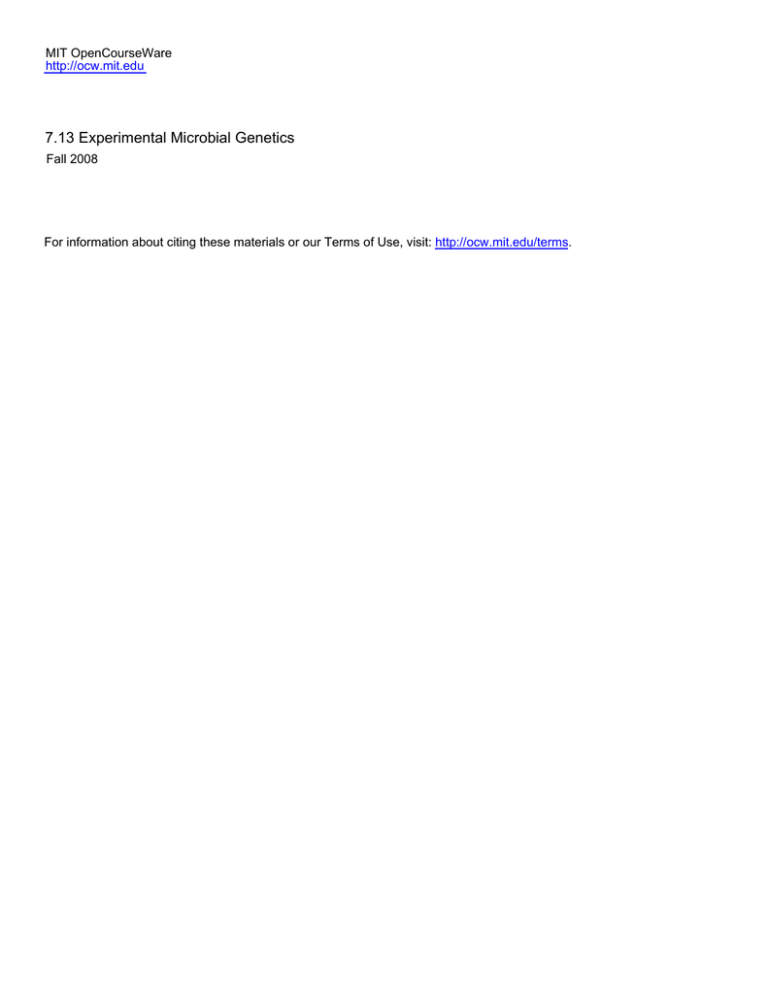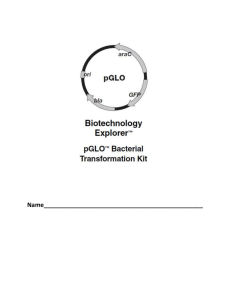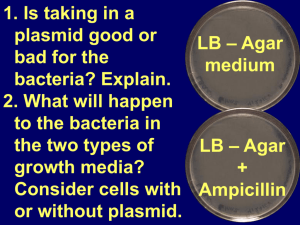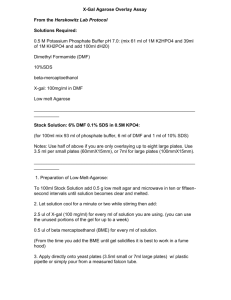7.13 Experimental Microbial Genetics MIT OpenCourseWare Fall 2008
advertisement

MIT OpenCourseWare http://ocw.mit.edu 7.13 Experimental Microbial Genetics Fall 2008 For information about citing these materials or our Terms of Use, visit: http://ocw.mit.edu/terms. 7.13 Fall 2008 Page |1 Transforming DH5α−T1R Chemically Competent Cells Genotype DH5α−T1R: F- φ80lacZΔM15 Δ(lacZYA-argF)U169 recA1 endA1 hsdR17(rk-, mk+) phoA supE44 thi-1 gyrA96 relA1 tonA (confers resistance to phage T1) General Handling: Be extremely gentle when working with competent cells. Competent cells are highly sensitive to changes in temperature or mechanical lysis caused by pipetting. Transformation should be started immediately following the thawing of the cells on ice. Mix by swirling or tapping the tube gently, not by pipetting or vortexing. You will need the following items for transformation: • 37°C shaking and non-shaking incubator • 10 cm diameter LB agar plates with appropriate antibiotic • Ice bucket with ice • 42°C water bath Before Starting • Pour LB agar plates with appropriate antibiotic (this should be done WELL in advance of starting this protocol; see note below) • Equilibrate a water bath to 42°C • Warm the vial of SOC medium to room temperature • Spread X-Gal onto LB agar plates with antibiotic, if desired (bee section on blue white screening below) • Warm the plates in a 37°C incubator for 30 minutes • Obtain a test tube rack that will hold all transformation tubes so that they can all be put into a 42°C water bath at once. Procedure The instructions provided below are for general use. Plasmid DNA should be free of phenol, ethanol, protein, and detergents for maximum transformation efficiency. NOTE: Although the protocol calls for SOC media to recover these cells, LB is fine for routine transformations with plasmid DNA. For ligations, SOC is preferable. The SOC medium recipe, should you need to make it, is at the end of this protocol. 1. Briefly centrifuge the ligation reaction and place on ice. 2. Thaw, on ice, one 50 μl vial of cells for each ligation/transformation. 3. Pipet 1 to 5 μl of each ligation reaction directly into the competent cells and mix by tapping gently. Do not mix by pipetting up and down. Store the remaining ligation reaction at -20°C. 4. Incubate the vial on ice for 30 minutes. 5. Incubate for exactly 30 seconds in the 42°C water bath. Do not mix or shake. 6. Remove vial from the 42°C bath and place on ice. 7. Add 250 μl of pre-warmed SOC medium to each vial. (SOC is a rich medium; sterile technique must be practiced to avoid contamination.) 7.13 Fall 2008 Page |2 8. Place the vial in a microcentrifuge rack on its side and secure with tape to avoid loss of the vial. Shake the vial at 37°C for exactly 1 hour at 225 rpm in a shaking incubator. 9. Spread 20 μl to 200 μl from each transformation vial on separate, labeled LB agar plates. We recommend that you plate two different volumes. Note: You may have to dilute cells 1:10 to obtain well-spaced colonies. 10. Store the remaining transformation reaction at +4°C and plate out the next day, if desired. 11. Invert the plates and incubate at 37°C overnight. 12. Select colonies and analyze by plasmid isolation, PCR, or sequencing. Transforming Control Plasmid DNA In parallel with your experimental plasmids or ligations, also perform a positive control transformation of DH5α-T1R with the supercoiled pUC19 plasmid supplied with the kit as described below. 1. Prepare LB agar plates containing 100 μg/ml ampicillin. 2. Transform 5 μl (50 pg) pUC19 into 50 μl of competent cells. 3. Follow Steps 4-8 above. 4. Dilute the transformation reaction 1:100 and plate 30 μl on selective plates. 5. Incubate overnight at 37°C and count colonies. Calculate transformation efficiency using the formula below. For chemically competent cells, use the formula below to calculate transformation efficiency as transformants per 1 μg of plasmid DNA: Expected transformation efficiency: >1 x 10^9 cfu/μg supercoiled plasmid Transformation efficiencies for cDNA and ligation of inserts to vectors will be lower than for a supercoiled control plasmid such as pUC19. • For cDNA, transformation efficiencies may be 10- to 100-fold lower. • For ligation of inserts to vectors, transformation efficiencies may be 10-fold lower. Blue-White Color Screening Blue-white color screening for recombinant plasmids is available when transforming this host strain with a plasmid that provides α-complementation. When lacZ is expressed by this strain in the presence of the chromogenic substrate X-gal, colonies containing plasmids with inserts will be white, while colonies containing plasmids without inserts will be blue. DH5α−T1R E. coli does not require IPTG to induce expression from the lac promoter. Plates for Blue-White Color Screening Spread 100 μl of 2% X-gal (prepared in dimethylformamide (DMF)) on solidified LB agar plates 30 minutes prior to plating the transformations. (For consistent color 7.13 Fall 2008 Page |3 development across the plate, pipet the X-gal into a 100-μl pool of SOC or LB medium and then spread the mixture across the plate. Preparation of Agar Plates LB Agar Plates (2%) – We can get agar from the kitchen. Pour plates about 2 days before required (they need time to dry). This means you need to be organized because you will need to order it in advance on the order sheet!!! Autoclave to melt agar. Let cool (high temperatures will inactivate the antibiotics) until hand warm/hot, about 55°C (agar should still be molten!). Add the appropriate antibiotic (add 1 ml of 100 mg/ml filter-sterilized ampicillin to 1L of agar, add 1ml of 50 mg/ml of filter-sterilized kanamycin to 1L of agar). Pour into petri dishes (~25 ml/100-mm plate). Leave to dry 1-2 days. Store upside down in bags the plates came in at 4°C. Use within a month. SOC Recipe (per one liter) 2% tryptone 0.5% yeast extract 10 mM sodium chloride 2.5 mM potassium chloride 10 mM magnesium chloride 10 mM magnesium sulfate 20 mM glucose






